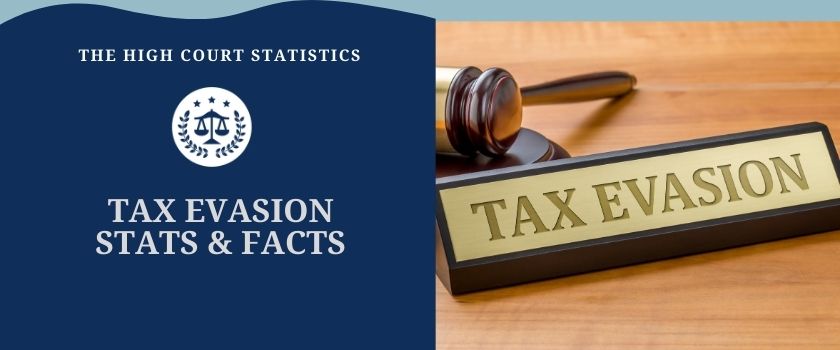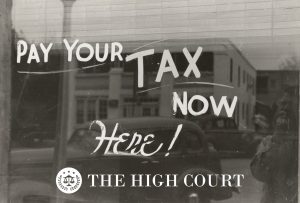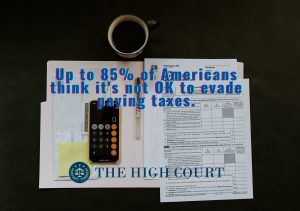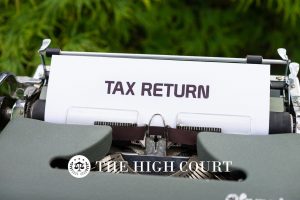
No one likes to pay taxes. But when avoidance tips into illegal willingly or unwillingly, we’re talking about tax evasion.
Tax evasion statistics show the more money you have, the less likely you’re willing to part with it.
The thing is:
The top earners are the ones that dodge taxes the most and are constantly coming up with innovative ways to do so. You’ll find some well-known names, from corporate giants, musicians and actors, and even presidents.
At The High Court, we always pay our taxes, but what happens when you don’t?
We decided to investigate.
Mind-Blowing Tax Evasion Statistics and Facts (Editor’s Picks)
- $600 billion is lost worldwide to tax avoidance each year.
- Tax evasion costs Europe from $55 to $75 billion a year.
- The annual loss of revenue due to unpaid taxes in the US is $458 billion.
- The top 10% are responsible for 68% of tax evasion.
- Up to 85% of Americans say it is not OK to evade taxes.
- Over 72% of all evasion comes from income tax evasion.
- Up to 63% of self-employed Americans evade taxes.
- The most massive individual tax evasion case is that of Walter Anderson, who owed $200 million in unpaid taxes.
Global Tax Evasion Statistics
1. Up to $1.38 trillion worth of profit is being shifted to tax havens every year.
(Source: World Finance, Washington Post)
By IMF calculations, over $600 billion a year go unpaid when it comes to tax evasion worldwide. Most of it happens in the US, Japan, and China. The latest reports reveal companies are moving a whopping $1.38 trillion worth of profit yearly to tax havens.
When it comes to individuals, countries are losing $182 billion a year in taxes due to tax haven accounts.
2. Up to 37% of global tax loss happens in UK crown territories.
(Source: Washington Post)
Bermuda, Cayman, Jersey, and the British Virgin Islands are tax havens responsible for over one-third of worldwide tax losses. These UK dependencies are at the top of the corporate and individual tax evasion enabler list, along with the state of Delaware and countries such as the Netherlands, Switzerland, and Luxembourg.
3. Big Tech is one of the largest tax evader groups, with Apple being ordered to pay $15.4 billion in back taxes in Ireland in 2017.
(Source: NBC)
Multinational tech giants such as Google, Apple, and Amazon are famous for their tax evasion and tax avoidance practices.
Apple was ordered to pay up to a whopping $15.4 billion in back taxes since it had only paid 1% of tax on profits in Europe in 2003 and only 0.005% in 2014.
Google was using existing loopholes to do the so-called “double Irish” and “Dutch sandwich” strategy to pay only 6% corporate tax instead of 19.3%.
And that’s not all:
Amazon sold £4.3 billion and paid only £4.2 million moving funds through Luxembourg, causing politicians to ask for a boycott of its services.

4. Europe loses anywhere from $55 billion and $75 billion per year to tax evasion.
(Source: World Finance, Statista)
Tax evasion in Europe has dropped by 12% to 16% since 2009. The estimates are that EU countries lost some €824 billion in unpaid taxes in 2015. Italy, Germany, and France were the leaders in tax losses, followed by the UK and Spain.
US Tax Evasion Statistics
5. There were 141 million taxpayers in the United States in 2019.
(Source: Tax Foundation, Journalist Resource)
The latest available IRS stats show that, as of May 2019, there were over 141 million individual income tax returns.
There were 143.3 million taxpayers in 2017. Their reported earnings were $10.9 trillion in adjusted gross income, and they paid $1.6 trillion in individual income taxes.
The income of the top 1% went up to 21% after being 19.7% the year before.
6. One in six dollars owed in federal taxes in the US is not paid.
(Source: Journalist Resource, Brookings, Investopedia)
What is the difference between tax avoidance and tax evasion?
Tax avoidance represents one’s effort within the law to legally lessen their tax amount. In fact, the IRS encourages writing off certain things.
So, what is tax evasion?
Tax evasion means the law has been broken, and earnings were not reported to the IRS, willfully or without knowledge. Overall, one in six dollars owed in federal taxes is not paid.
And that’s not all:
Concealing income offshore represents a form of tax evasion, as US citizens have to pay the taxes on income made inside and outside the country. In contrast, non-residents pay tax only on income made in the US.
The International Consortium of Investigative Journalists revealed that in the Panama Papers and Swiss Leaks, the leaked documents about tax havens were related to 214,000 offshore companies.
7. Over $458 billion is lost to tax evasion every year.
(Source: Journalist Resource)
What are the effects of tax evasion?
Federal tax evasion, looking at IRS tax evasion statistics on intentional evasion and unintentional errors, has led to the loss of revenue of over $458 billion per year.
8. The “net tax gap” in 2008-2010 was $406 billion.
(Source: Journalist Resource)
In 2019, the Government Accountability Office reported the net tax gap amounts to $406 billion, representing the sum after late payments are pursued and enforcement is undertaken. The reports cover data from 2008 to 2010, which is the most recent available estimate.
9. The tax gap in 2018 might be around $600 billion.
(Source: Brookings, IRS, Journalist Resource)
Tax evasion in the USA can be estimated by looking at 2010 figures and knowing that 16% of taxes were not paid. This is equal to 2.8% of the annual gross domestic product and 18% of the annual federal revenues for that time.
If the situation hasn’t changed relative to the tax revenues, the figure is around $600 billion.
For comparison, the tax gap could be almost 80% of the federal budget deficit, as it was $779 billion in 2018. It’s also equal to 37% of the $1.1 trillion budget of the Department of Defense in 2019.
10. About 72% of all evasion comes from income tax evasion.
(Source: IRS)
Evasion rates are different when it comes to different types of taxes. They’re pretty high looking at income taxes, which are paid at a rate of 44% and evaded in 72% of cases.
Payroll taxes have far fewer cases of evasion. They’re the second source of government revenue in the US, with only 19% of tax evasion and 39% of taxes paid.
Corporate tax evasion statistics show that the corporate taxes amount to 9%, both for evaded and paid categories.
11. Up to 84% of the tax gap comes from underreporting.
(Source: Top Tax Defenders, Journalist Resource)
What is an example of tax evasion?
Tax evasion has many forms. It may look like underreporting income, falsifying income records, underpaying taxes on purpose, inflating expenses and deductions, and hiding money and interest in offshore accounts.
The most common form of tax evasion is underreporting. It accounts for 84% of the tax gap between 2008 and 2010, the 2019 Government Accountability Office report found. This happens when people working multiple jobs report only one source of income.
The second and third most common sources of tax evasion are underpayment and non-filing.
How Common Is Tax Evasion?
12. Up to 85% of Americans think it’s not OK to evade paying taxes.
(Source: Journalist Resource)
In 2018, the IRS did a Comprehensive Taxpayer Attitude Survey, which found 85% of Americans believed was never alright to evade paying taxes. This was actually a decline from 2017 when 88% believed that.

13. Tax evasion is very common among the self-employed, with a non-compliance rate of 63%.
(Source: Journalist Resource)
Is tax evasion common?
Tax evasion is very common in cases where incomes are subject to reporting by third parties such as employers. But with the self-employed, tax evasion happens in 63% of cases according to the IRS data. In cases with reporting, only 1% of taxes are misreported.
14. The top 10% accounts for 61% of all tax evasion.
(Source: Brookings)
The higher the household is on the socioeconomic ladder, the greater the likelihood of tax evasion. The top 10% of earners were responsible for as much as 61% of tax evasion, while they accounted for only 44% of income.
What’s more:
Looking at how common is tax evasion, those in the top 1% were responsible for 28% of unpaid taxes and 18% of earned income.
The bottom half is responsible for 12% of unpaid taxes and 14% of income.
15. IRS funding went down by 12% from 2008 to 2017.
(Source: Brookings)
IRS employment went down by 15% over this period, and its funding decreased by 12%, with the enforcement division facing the largest cuts.
16. Audit rates are cut by 50% compared to 20 years ago.
(Source: Brookings)
Over the last two decades, audit rates have dropped by half. The IRS reports auditing 0.6% of individual and 1% of corporate returns in 2017. The numbers stood at 1.0% for private and 2.1% for corporate in 1998.
17. The telephone wait time for IRS assistance has increased by 17 minutes in the last decade.
(Source: Brookings)
Customer service is also reduced greatly, as only 38% of taxpayers reported getting assistance upon calling the IRS in 2015, while that number was 70% in 2011.
Additionally, the average for the time one had to spend on the telephone waiting has gone up considerably.
Famous Tax Evaders
So, who goes to jail for tax evasion? Let’s have a look at some of the most well-known tax evaders in America who got caught.
18. Al Capone was arrested for failing to pay taxes worth of $4 million in today’s dollars.
(Source: Accounting School Guide)
When it comes to one of the most famous criminals, Al Capone, also known as Scarface, was not sent to prison for his most notorious crimes. Instead, what ultimately landed him in Alcatraz was dodging taxes.
The sum of his tax bill at the time was $270,000, which amounts to around $4 million today.
19. Walter Anderson has the largest individual tax bill, owing over $200 million.
(Source: Accounting School Guide)
Businessman Walter Anderson, a telecom entrepreneur, is involved in one of the largest and longest tax evasion cases against an individual, owing over $200 million. He’s spent over six years in prison.
20. Lauryn Hill served three months in the federal prison that also inspired the show Orange Is the New Black for evading taxes.
(Source: Accounting School Guide)
A sentence for tax evasion will not pass you by even if you’re rich and famous. One of the best examples is singer Lauryn Hill, who spent three months in a federal prison for not paying taxes to the amount of $2.3 million.
21. Nicolas Cage was charged for $6.2 million in tax evasion.
(Source: History By Day, Accounting School Guide)
The Hollywood star failed to properly calculate his taxes for 2009 when he made over $40 million, resulting in $6.2 million back taxes.
Another famous actor, Wesley Snipes, served three years for tax evasion to the amount of $7 million.
22. Pete Rose was charged for avoiding to pay taxes of $410,000 the first time and $1 million the second time.
(Source: Accounting School Guide)
Baseball star Pete Rose served time in Illinois after failing to pay taxes to the amount of $410,000. After the five-month sentence he served for that sum, another tax evasion charge was brought against him for the sum of $1 million years later.
23. Willie Nelson negotiated his taxes down from $16.7 to $6 million.
(Source: History By Day)
Famous for his country music, Willie Nelson partially paid his tax debt through the double album named The IRS Tapes: Who’ll Buy My Memories?, after being charged for a whopping $16.7 million in unpaid taxes. He blamed his accounting company, PricewaterhouseCoopers, for the error.
24. Richard Hatch of Survivor served time for tax evasion twice.
(Source: Accounting School Guide)
Famous for his appearance on the reality TV show Survivor, Richard Hatch spent time in prison two times, failing to pay his debt after his first tax evasion prison stay. The amount of tax debt was $2 million, and he spent over four years behind bars
25. Vice president Spiro Agnew owed $10,000 in taxes and resigned from office.
(Source: History By Day, Accounting School Guide)
Even vice presidents could turn tax evaders, as was the case with Spiro T. Agnew, Richard Nixon’s vice president. Charged with tax fraud, conspiracy, and bribery, he resigned from office in 1973, becoming only the second vice president to do so. He settled on federal tax fraud charges for the debt and got the prosecution to drop the corruption charges, receiving three years of probation.
26. O.J. Simpson owed $500,000 in taxes.
(Source: Accounting School Guide)
Among his other famous issues with the law, the football player, actor, and central figure of the murder case of the century as some called it, also had an outstanding unpaid tax bill of $500,000.
27. Abbott and Costello owed $500,000 near the end of their careers.
(Source: Accounting School Guide)
The famous comedians owed half a million dollars, a sum equal to $3.9 million today. As a result, they were forced to sell their companies and homes.
28. The Trump family avoided paying hundreds of millions of dollars, avoiding the 55% tax rate on gifts.
(Source: World Finance)
The number of scandals the Trump family has been involved in is growing by the day. After a year and a half long investigation of Trump’s tax records, a string of instances of tax fraud surfaced. It shed light on a long-term family practice when it comes to properties that lowered their tax bills by hundreds of millions, evading the 55% tax rate on gifts. The full extent of federal tax crimes the family has been involved in is yet to be determined. Jared Kushner, Trump’s son-in-law, allegedly profited a mind-blowing $324 million from depreciation.
Famous Corporate Tax Evasion Cases
29. The Panama Papers leak yielded over $700 million reclaimed in fines and back taxes.
(Source: World Finance)
The leaked archives of a Panama law and corporate service company, Mossack Fonseca, revealed 11.5 million compromising documents in 2016. The exposed financial information of around 215,000 offshore accounts with over 40,000 individual and corporate clients also revealed a long list of dodgers.
In June 2018, over $700 million were reclaimed in fines and back taxes from the entities involved with Mossack Fonseca.
And that’s not all:
More than 12 world leaders and 128 public officials were implicated, such as former British and Icelandic prime ministers David Cameron and Sigmundur Davíð Gunnlaugsson, banker Éric de Rothschild, and the CEO of Citigroup, Sanford I. Weill.
30. Germany lost €31.8 billion to loopholes with ex/cum trades.
(Source: World Finance)
These practices of applying for multiple refunds on capital gains taxes, which were outlawed in 2012 and 2016, continue to function through a network in London. They caused Germany the loss of over €31.8 billion in tax due to the “cum/cum” and “ex/cum” schemes of bankers and brokers. Ultimately, it’s the biggest tax fraud scheme in Germany to date according to tax fraud statistics.

31. Bank of America would owe $4.3 billion if it reported its taxes.
(Source: Institute for Policy Studies report)
One of the most prominent corporate tax evasion cases is that of Bank of America. The company made $17.2 billion in offshore profits in 2012 yet paid no US taxes at all. If the profits were reported, it would have to pay up to $4.3 billion in taxes. The company paid only 10% in tax to other countries, shifting its profits to tax havens.
Out of 594 Bank of America subsidiaries in other countries, 313 are located in offshore tax-havens. Specifically, 175 of them are in the Cayman Islands, a haven that has an astonishing 161 registered companies per 100 citizens.
As a true champion of financial manipulation, Bank of America settled its abusive lending charges by paying $2.7 billion, then saved $1 billion in 2012 taxes by deducting the cost of the settlements, all of that after the taxpayers’ previous bailout.
It doesn’t come as a surprise, as the company’s CEO is one of the leading voices in attempts to lower corporate taxes even further, raise the retirement age from 67 to 70, and cut social security, all the while sporting a retirement monthly income of $50,571. That’s a whopping 40 times more than the average American can expect.
32. Citigroup would owe $11.5 billion if it brought profits home.
(Source: Institute for Policy Studies report)
Citigroup’s offshore profits in 2012 reached $42.6 billion, without any taxes paid in the United States. The amount of taxes paid to foreign countries is just 8%. This leaves it enough to be able to spend $6 million lobbying Congress every year, with 85% or 53 of 62 of Citigroup’s lobbyists being former members of Congress or staff.
33. ExxonMobil spent $193 million lobbying Congress, with tax issues as the main interest point.
(Source: Institute for Policy Studies report)
Aside from fracking and oil price rises, ExxonMobil profits considerably from tax dodging. It paid only 15% of federal income tax in 2010-2012 when the corporate tax is 35%, benefiting to the tune of $6.2 billion. ExxonMobil had $43 billion in offshore profits during the period, with no taxes paid in the US.
It doesn’t end there:
ExxonMobil reported $2.5 billion in US profits in 2009 and received a $954 million federal tax rebate when it reached a settlement in the Exxon Valdez spill case in Alaska. The company deduced the cost of the settlement and reduced its tax bill by half a billion dollars, already paid for by taxpayers. Over the last 15 years, ExxonMobil has spent 193 million lobbying Congress.
34. FedEx made $5.7 billion in 2010-2012 without paying any taxes.
(Source; Institute for Policy Studies report)
Another giant on the list of corporate examples of tax evasion is FedEx. FedEx made $5.7 billion in 2010-2012 without paying taxes and got a subsidy of $2.1 billion. Additionally, it got $10.3 billion in federal contracts during the same period.
35. General Electric paid only 2.4% in taxes.
(Source: Institute for Policy Studies report)
Also among the list of famous corporate tax dodgers, General Electrics made $88 billion between 2002 and 2012. It paid just 2.4% in taxes and got a subsidy of $29 billion. The company earned $108 billion in offshore profits without paying any taxes in 2012, while receiving offshore profits to the amunt of $21.8 billion in federal contracts between 2006 and 2012.
Check this out:
Allegedly, General Electric’s tax return spanned over 57,000 pages in 2011, showcasing how it’s possible to turn tax evasion into a business strategy and earn more from financial schemes than from selling your main product.
36. Honeywell avoided 1.7 billion in taxes, tax evasion statistics confirm.
(Source: Institute for Policy Studies report)
One of the loudest Fix the Debt voices, CEO David Cote was asking for social security and Medicare cuts while dodging paying any taxes through numerous loopholes. In effect, he was paying only 1% taxes. Altogether, the company avoided $1.7 billion in taxes.
Honeywell made $5 billion in the years from 2009 to 2012 and paid a mere $50million in federal income taxes. Honeywell had $11.6 billion in offshore profits with no taxes paid.
37. Merck paid half of the official 35% tax rate.
(Source: Institute for Policy Studies report)
The company had $53.4 billion in its offshore accounts in 2012, making it one of the biggest tax dodgers in the US.
Merck made $13.6 billion and paid $2.5 billion in federal income taxes for the period from 2009 to 2012, paying 18.4% federal income tax rate, which is half the official 35% corporate rate, and getting a subsidy of $2.2 billion.
Last but not least:
The amount the company received in federal contracts in federal contracts from 2006 to 2012 was $8.7 billion.
38. Microsoft would owe $19.4 billion if profits were brought home from Puerto Rico, tax evasion statistics reveal.
(Source: Institute for Policy Studies report)
The company is said to have saved over $4.5 billion in federal income taxes during the time period from 2009 to 2011 by using a Puerto Rico subsidiary. Microsoft had $60.8 billion in offshore accounts in 2012, so it would owe an eye-watering $19.4 billion.
It gets worse:
[bctt tweet=”An estimated 47 cents of every dollar of product that Microsoft sells in the United States are moved to the Puerto Rico subsidiary.” via=”no”]
The company has earned $20 billion and paid $9.8 billion in federal income taxes for the years 2010 to 2012.
39. Pfizer earned $73 billion in offshore profits in 2012, paying no taxes.
(Source: Institute for Policy Studies report)
Pfizer earned $43 billion globally and got $2.2 billion in federal tax refunds in 2010-2012 after reporting $9 billion in losses in the US.
The company’s offshore accounts reached $73 billion in profits, and it received $3.4 billion in federal contracts during the same period.
40. Verizon got $535 million in tax rebates and paid no taxes.
(Source: Institute for Policy Studies report)
The company paid no taxes after making $19.3 billion in US pretax profits during the years 2008-2012, but it received $535 million in tax rebates. Verizon got a subsidy of $7.3 billion and over $6 billion in federal contracts, looking at the period from 2011 to 2023.
41. The average prison sentence for evading taxes is three to five years, and penalties can reach $500,000.
(Source: Rosenberg Martin, Lexology)
What is the penalty for tax evasion?
Under federal law, not filing a tax return is a misdemeanor, and an “overt act of evasion” is a felony.
Now:
The average jail time for tax evasion is three to five years, and the penalty for tax evasion ranges from $250,000 for individuals and $500,000 for corporations. Other tax fraud crimes can reach penalties up to $100,000 for individuals and $250,000 for companies.
The Bottom Line
Tax evasion statistics reveal many rich and famous names. And as we’ve seen, being well known won’t save you from prison time. However, the closer you are to the top, the less likely you are to spend time behind bars.
The thing is:
The top 10%, the largest group to engage in tax fraud and tax evasion, exploit a multitude of loopholes and tax haven options. The rich spend millions every year in order to make themselves even richer.
Key takeaway:
Tax evasion statistics reveal corporate giants and banks have turned tax evasion into an art form and a proper business model in itself.
Sources:

